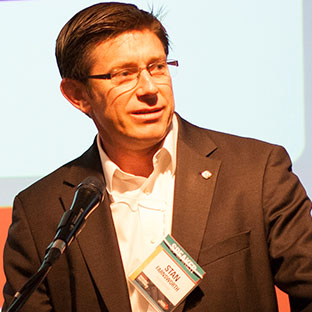

NovaCentrix’s Stan Farnsworth presenting at CPES2015
“We can’t even imagine what products will be
on the market, built by what technologies, 10 years from now,” said Stan Farnsworth, NovaCentrix’s VP Marketing.
And yet, NovaCentrix has been peering into the crystal ball and taking calculated risks on where the market might be for the past 16 years.
NovaCentrix is the Diamond Sponsor for CPES2016. Today, the company is widely respected in the printable, flexible and organic electronics industries for its Metalon conductive inks, and even more so as a pioneer in photonic curing tools under its PulseForge brand.
PulseForge tools are used to dry, sinter or anneal thin-film materials on substrates, including papers and plastics that can’t take the high heat required by other curing processes. Photonic curing saves product material costs, reduces processing time and increases throughput.
Keeping ahead of the market curve
It’s a product lineup with market applications NovaCentrix’s founders could scarce imagine when they founded the company 16 years ago.
“Even the precursors of the technologies we are working with today didn’t exist back then,” Farnsworth said. “We’ve pivoted so many times, we’ve had so many changes in ownership structures and products and technologies, it’s really not the same company, even though we have the same technical team.”
In true tech startup fashion, NovaCentrix has always kept its attention fixed firm on what lays just over the horizon. Conventional marketing wisdom holds that new product development should be driven by market pull. But in NovaCentrix’s case, it’s always been a balancing act between what the market wants and doesn’t yet know it needs.
“We’ve often faced that cart-and-horse problem, where the technologies we were developing and productizing were vital for the market to move forward, but our prospective customers didn’t know they needed them yet,” Farnsworth said. “If we let the market drive the technology, the technology wouldn’t exist. Nobody came to us and said, ‘we need a photonic curing tool.’”
It all began in 1999, when a team from the University of Texas in Austin led by Dr. Dennis Wilson decided to take their developments in dry nano powders from the academic lab to market through a startup.
From nano powders to printable electronics
A multi-million-dollar Series A venture capital round gave them the resources to develop the R&D, management and business development teams. Farnsworth, who had been working with the founders since 1999, was the first full-time hire.
Over the next several years, NovaCentrix continued to evolve through additional rounds of VC, but found itself with more technical successes in the R&D lab than with sustained business successes on the sales front.
The team decided to move further downstream in the supply chain, where it could help end-users overcome adoption hurdles to incorporate NovaCentrix’s nanomaterial products into theirs at scale. The company parlayed its expertise with nano powders into conductive inks, antimicrobial applications, and nanoaluminum for the defence sector.
In 2007, NovaCentrix decided to focus on the market its investors felt had the most “home run” potential – conductive inks for the electronics market. That’s when the team realized it had the technical expertise in photonic curing to overcome a key bottleneck in manufacturing printable electronics with heat-sensitive substrates like paper and plastic. PulseForge moved from a limited-scale effort to a strategic initiative. It’s been a process of fast-paced iterative product development since, driven by customer engagement and in-house learning.
“It’s always been in the DNA of the company to be innovative and keep aware of new markets and applications,” Farnsworth said. “We’re always exploring for new inspiration around products and innovative technologies, and how to deliver compelling and enabling products.”
Taking the pulse of the future
Which brings us to 2016, and the future tech of the Consumer Electronics Show.
“Even over the next six months, there are so many incredible things happening with materials science, electronics, chemistry,” Farnsworth said. “Our customers are working on displays, batteries, sensors, and 3D fabrication, for applications in consumer electronics, automotive, and wearables with garments and devices. We observed at CES that our customers’ projects are spot on with the macro trends in technology.”
While the world’s biggest brands are waking up and taking notice of the vast potential for printable, flexible and organic electronics, Farnsworth believes there’s still plenty of room for smaller companies to get involved.
“This industry is still at such an early stage we need communication and collaboration at all levels of the value chain to bring to market products that customers will respond to,” he said.